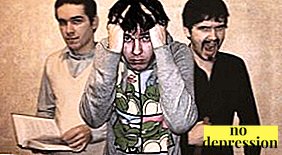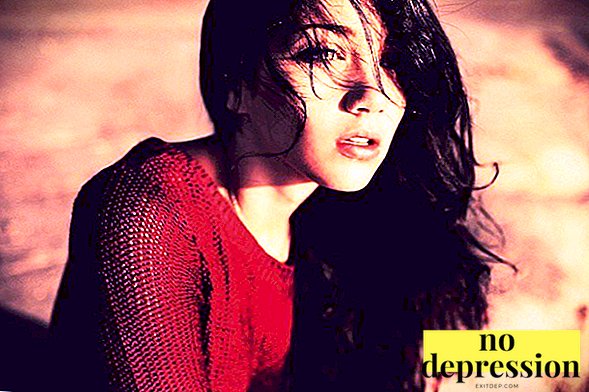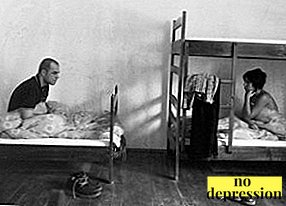Consciousness is an integral part of the concept of "personality".
It makes it possible to fully analyze information coming from the outside world, compare it with existing knowledge and experience, draw conclusions, use cognitive abilities, understand what is happening at one time or another, and feel oneself.
TO main types disturbances of consciousness include stunning, coma, stupor, delirium, oneiroid, amentia.
Split

Splitting consciousness - a definition that has a number of different interpretations and is used differently by various authors.
But, one way or another, splitting means a state in which the individual’s consciousness separates, the perception of reality changes, and the sense of “I” is lost to some extent.
Basic interpretations of the definition:
- Schizophrenia. The very name of this mental illness is translated as "cleavage of thinking", "cleavage of the mind" from ancient Greek.
Therefore, sometimes this phrase can be found in the topics of schizophrenia, used as a synonym. It can also describe some schizophrenic symptoms.
- Mental Disordersobserved in a number of mental and somatic diseases, such as dementia. This confusion of thinking, schizophasia, the desire to continuously produce delusional sayings that seem deeply to the patient. However, in this context, the definition is used relatively infrequently.
- Dissociative identity disorderwhich most people know as “split personality”. This is a mental illness in which the person’s personality seems to split into two or more parts, and each of these fragments begins to display his own personality, often with individual habits, interests, worldview, which periodically gains the opportunity to express themselves.

In modern psychology, the term "splitting of consciousness" is most often applies specifically to dissociative identity disorder: a complex, controversial mental illness.
Repeatedly there were cases when the criminals, trying to avoid punishment, began to talk about the fact that it was not they who committed the crime, but their other evil person (or persons).
Violation
Impairment of consciousness - a complex of disorders of different etiology and symptomatology, in which there are deviations in the functions that are the basis of consciousness.
They can develop on the background mental disorders, organic brain damage (including traumatic injuries, complications of infectious diseases, the effects of intoxication associated with diseases of the kidneys, liver), chronic and acute toxic substances.
Consciousness disorders can be divided, depending on severity, into:
- lungs;
- moderate;
- heavy.

All disorders of consciousness extremely heterogeneoustherefore it is difficult to compare them.
Some violations easily pass, sometimes even without the use of drugs and the help of health professionals.
But from others, such as stupor, coma, it is possible not to remove a person in all cases. They always indicate that the patient is in serious condition and may die.
Self-awareness - One of the key elements of consciousness, allowing a person to feel his body, to realize his own personality, to feel its integrity, to analyze their own actions, experiences, to understand who he is, what he wants, what he dreams of.
Respectively, self-consciousness disorders violate these functions. A person can feel that his body or personality does not belong to him, that they are alien to him, to lose the ability to notice the body and its signals, even to feel that he is becoming something else.
They may also develop on the background of mental or somatic diseases.
Causes of development
Severe disorders of consciousness are most often observed. with organic brain damage. The main causes of organic damage:
- Stroke and other vascular pathologies. Consciousness disorders can be observed both with ischemic (developing because a thrombus occluded the vessel and blocked the access of blood) and hemorrhagic (extensive cerebral hemorrhage due to an artery rupture, for example, due to aneurysm) stroke. Chronic diseases of the cardiovascular system, such as arterial hypertension, atherosclerosis, can also provoke disorders of consciousness over time.
- Head injuries The more serious the traumatic injury, the greater the chances that a person will experience a disorder of consciousness.
- Neoplasms in brain tissue. They can be either benign or malignant. In this case, severe impairment of consciousness can be triggered by a benign tumor, if it is large and increases in size. In addition to impaired consciousness, patients may experience cognitive impairment, headaches.
- Damage associated with the activity of pathogenic microorganisms. They can develop against the background of many infectious diseases, especially if a person has a weakened immune system. Most often, impaired consciousness is associated with the effects of meningitis and encephalitis. Adults with a strong immune system rarely suffer from meningitis, this disease is in most cases observed in young children (children's immunity is imperfect).
Those who regularly visit the habitats of encephalitic ticks, it is important to vaccinate in time and follow the rules of protection.
- Acute or chronic intoxication. Toxins are often alcohol, which has been consumed in large quantities for a long time, methanol (in self-made alcoholic beverages), low-quality narcotic drugs, toxic substances that can be encountered in production (mercury, chlorine, ammonia, fluorine, arsenic hydrogen, etc.).
- Neurodegenerative diseases: Alzheimer's syndrome, Pick's disease. Most often develop in the elderly and senile age. However, there are also diseases that occur in young people, such as Huntington's disease.


Consciousness disorders are also common in certain diseases and pathological states of the psyche, such as schizophrenia, affect, manic syndrome, psychosis, and certain types of depression.
Sleep deprivation (systematic lack of sleep or a complete lack of sleep) can lead to the development of disorders of consciousness.
Types and symptoms of disorders
The most dangerous and severe impairment of consciousness is coma - a condition representing a threat to human life that can end in death.
The main signs of coma:
- lack of signs of consciousness;
- reflex reactions are absent or extremely weak;
- pathological changes in the nature of respiratory movements;
- rapid or slow heartbeat;
- deviations in thermoregulation processes.

Varieties of coma, there is a huge amount, depending on the causes of it. The most famous types of coma are:
- endocrine;
- cerebral;
- hypoglycemic;
- diabetic;
- toxic.
There are the following stages of coma:
- Prekoma. Consciousness confused, the patient is stunned, inhibited, drowsy.
However, sometimes the precoma is accompanied by emotional and motor agitation, delusions and hallucinations can be observed.
Coordination is impaired, reflex reactions persist.
- I degree. The patient is noticeably stunned, responds slowly to stimuli (even to pain), can perform simple actions at the request, drink liquids and chopped food, change the position while lying in bed, but it is problematic to verbally interact with him. His muscles are tense. Many reflexes are disturbed.
- II degree. The patient is in stupor, extremely weakly reacts to pain, breathing is impaired (intermittent breathing, stridor or other types of respiratory pathologies), pathological reflexes are observed, only pharyngeal and corneal reflexes remain unchanged.
- III degree. The patient does not respond to pain, muscle hypotonia is observed, body temperature is lowered, pupils do not respond to light, blood pressure is lowered, respiratory movements are uneven.
- IV degree. There are no reflexes, the pupil is greatly dilated, the blood pressure is extremely low. Almost always fatal.
Other disorders of consciousness:
- Loss of consciousness. It may occur even in healthy people (for example, due to severe stuffiness).
- Stunning. When stunning, there is increased drowsiness, the patient reacts weakly to external stimuli, poorly oriented in space, it is difficult for him to answer questions. There are two degrees of stunning: moderate and deep.
- Sopor. The patient does not answer the questions, does not fulfill the request, there is no reaction to the surrounding phenomena, the muscles are in the hypotone, deep reflexes are oppressed.
- Akinetic mutism. A condition in which the patient, having opportunities for physical activity, does not move, does not speak. Rarely observed.
- Awake coma. Contact with the patient is impossible, he has no psycho-emotional reactions, but his eyes are open, he is moving.
- Vegetative state. Some of the reflexes remain, but mental activity is absent.
The longer a person is in this state, the lower the probability that he will wake up and be able to recover.

There are also disorders of consciousness often associated with mental illness (however, they can also be observed with deviations of somatic nature). These include:
- Catatonic syndrome. The main symptom of catatonia is the presence of movement disorders, manifested either in the form of catatonic excitement (the patient says pathos sayings, laughs for no reason, can be dangerous), or a catatonic stupor (the patient does not speak, does not move, his muscles are tense).
- Twilight stupefaction. Abruptly begins and ends abruptly. May be accompanied by a feeling of fear, anxiety, anger. Symptoms depend on the disease with which the condition is associated.
- Oneiroid syndrome. The patient begins to see fantastic images, woven with reality. It can be combined with catatonia.
- Delirium. For this condition is characterized by the presence of hallucinations, delusions, patients can show aggression towards themselves and those around him. Often observed due to toxic substances.
- Amental syndrome. Thinking and speech are incoherent, motor activity is unsystematic, disorientation is noted, the appearance of hallucinations and delusions is possible.

Diagnostics
Features of diagnosis depend on the general condition of the patient. The most common diagnosis of disorders of consciousness involved psychiatrists and neurologists.
The following can be assigned surveys:
- checking reflexes and reactions to external stimuli;
- electroencephalogram;
- computed and magnetic resonance imaging;
- consultation with a specialist (neurologist, psychiatrist).
Of course, the methods of diagnosis of coma significantly different from the diagnosis, for example, delirium.
If disturbances of consciousness are associated with any somatic pathology, diagnostic measures are taken to determine the patient’s condition.
Treatment

Methods of treatment depend on the background of what disease the disorder has developed and what type it is related to.
The attending physicians who oversaw the diagnostic process determine optimal treatment tactics in every single case.
Treatment of disorders of consciousness associated with mental disorders, takes place in a psychiatric hospital under the supervision of psychiatrists, who select the appropriate drug therapy.
Can be assigned antipsychotics, tranquilizers, drugs from the group of benzondiazepines (eg, Diazepam often used in the treatment of twilight stupefaction).
If the disorders are associated with somatic disorders, the therapy is aimed at normalizing the patient's condition and is carried out in accordance with the norms of treatment of a particular pathological condition.
If necessary, the patient is placed in hospital or resuscitation, conduct resuscitation measures, connect to the apparatus that supports his breathing and blood circulation.
Forecast depends on the severity of pathologies that provoked the disorder, the availability of quality and timely medical care.
The concept of consciousness and its violations, the degree of violation and first aid:



